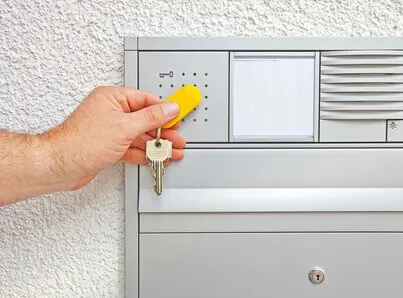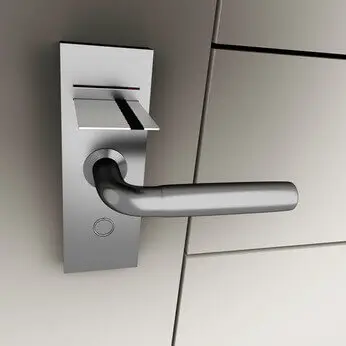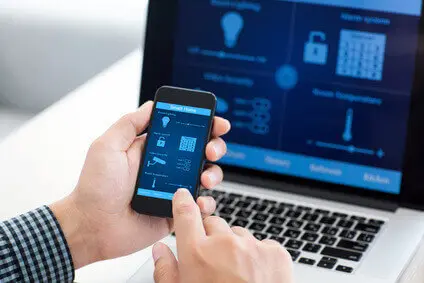With the increasing security requirements, not only for very large and complex buildings, but also for smaller residential units or similar, the installation of electronic locking systems is becoming more and more important.
Various new technologies make it possible to put together different locking concepts for every type of building. From the single-family home to large properties that are heavily frequented by many users or visitors, such as companies or public buildings, building systems can be either equipped or retrofitted with the appropriate electronic locking systems.
Table of contents
Reasons for the increased use of electronic locking systemsThe various basic concepts of electronic locking systemsControlling electronic locking systems with appropriate hardware and softwareThe keyless houseThe intelligence of thingsPlanning an electronic locking system
Reasons for the increased use of electronic locking systems
In addition to the increase in security requirements, greater flexibility and the often better price-performance ratio play a major role in the installation of electronic locking systems.
The damage caused, for example, by the loss of a mechanical master key, resulting in the complete replacement of the locking system, can mean considerable costs. In the case of a public building or large company, such a master key can even be designed for several thousand doors.
With electronic locking systems, it is possible to create an authorisation plan for the respective users and to change it again if necessary.
In this way, only certain users are granted access authorisations, which can also be revoked at any time.
In addition to the security requirements, the flexible demands on locking systems have also increased considerably in recent years. Rooms, such as those in open-plan offices, are rented out and frequently change users. Or departments in public buildings are frequently restructured, also with changing mergers or separations of users.
Entire buildings may be rented out for short periods only. It is often no longer possible for mechanical locking systems to adapt to these requirements, which change at ever shorter intervals, with the allocation of constantly changing locking authorisations.

The different basic concepts of electronic locking systems
A great advantage of electronic locking systems is that there are different basic technological concepts for them. This means that mechanical locking systems can also be converted. These different concepts also make it possible to install the right locking system for every requirement and size of building. The manufacturer ABUS offers a product overview of electronic locking systems on its website.
The basic components of electronic locking systems that can be combined with each other, the so-called ident media, include:
Key with electronicsChip cardTransponder
These Ident media can be combined with fully electronic locking cylinders, mechatronic locking cylinders or fully electronic fittings. These combination possibilities result in the following basic concepts:
Access control systems (with transponder or chip card as control elements for motorised locks)Mechatronic systems (with battery-operated electronic keys)Fully electronic locking systems (battery-operated locking systems also with transponder or chip card).
With mechatronic and fully electronic systems, the doors can be equipped with the respective locking cylinders and installed with different knob combinations. Thus, there can be only inside knobs, inside and outside knobs or no knobs at all on the doors.

Control of electronic locking systems with corresponding hardware and software
The control of electronic locking systems via EDP systems with the corresponding software is becoming increasingly important as the systems expand and take on different tasks.
In the case of access control systems that were almost considered “classic”, using chip cards, transponders and digitalised locks, relatively costly wiring of the entire door was still necessary. In the meantime, battery-operated mechatronic or fully electronic locking systems, with appropriate control by hardware and software in the background, offer convenient solutions for setting up locking networks.
The keyless house
In these computer-controlled and programmable locking systems, as well as networks, it is possible to manage almost unlimited locking units. For example, locking authorisations for users can be programmed and changed centrally on a PC or on the digital locks. Locking logs are created automatically and show with which locking authorisation doors were opened.
Unauthorised access attempts from locked areas or without possession of an access authorisation can also be recorded. Furthermore, it is possible to define which user may open or close which doors, and at what times.
Motor-controlled locking systems enable automatic unlocking and locking of doors at specific times. Alarm systems can also be controlled and activated or deactivated using transponders or the IT system, for example.
These measures greatly increase security against unauthorised access or locking.
In smaller residential units, such as single-family houses, electronic locking systems operated via pin code keypads have become very popular.
These pincode keypads can be programmed for different applications and provided with a master code, which then assumes the function of the former mechanical central key. With these technological innovations, the keyless home has become a reality.

The intelligence of things
The future belongs to the so-called “intelligence of things” or also referred to as the “Internet of Things”.
For electronic locking systems, this future controlled via the Internet (using WLAN or WiFi) could mean that doors “independently” recognise when they should open or close, which persons should be allowed to enter the house or certain areas, and at what times.
Perhaps the weekly shopping, transmitted to the supermarket via the Internet by an intelligent refrigerator, is delivered while the owner of the house is working in his office. The smart locking system recognises the delivery man by sensor and grants him access to a delivery area specifically designated for deliveries. These future visions no longer seem unthinkable given the speed of technological innovation.
Planning an electronic locking system
Since there are a multitude of possibilities for the conception of an electronic locking system for different types of buildings, careful planning is necessary. Errors or overlooked details in planning can lead to serious consequential costs.
The planned system should already have proven itself in practice. The individual components – the electronic locking cylinders, the fittings, the keys and transponders, and the associated software – should work together reliably. The planned locking system must fit all the doors in the building and the conditions surrounding them.
For example, the dimensions, the frame profiles, mechanical loads, the outside and inside temperature, air humidity, magnetic or electromagnetic radiation and much more can have a great influence on the technical components, as well as their cooperation within the electronic locking system.
It is often a good idea to carry out a small test installation in your own building before purchasing a large new system.
If you are a builder for your own home, a business owner for your company or a decision-maker in public administration and want to have an electronic locking system installed in one or more buildings, you should seek detailed advice from a specialist company on the various alternative concepts for an optimum system. Also ask the company you have commissioned to install the system whether it is possible to carry out a test installation on a smaller area with a few doors before installing a larger new electronic locking system.
When it comes to electronic locking systems, the security of your property is paramount. At London Locksmith 247, we understand the importance of advanced technology in safeguarding your home or business. Our expertise lies in providing cutting-edge electronic locking solutions that offer unparalleled protection against intruders. With our state-of-the-art systems, you can have peace of mind knowing that your premises are fortified with the latest security measures. As a trusted locksmith service provider, we serve various areas in London, including Soho. Whether you’re in need of locksmith services in Soho or require assistance in other parts of the city, our dedicated team is here to help. In addition to electronic locking systems, we also specialize in burglary repair in London. If you’ve experienced a break-in, our skilled technicians can swiftly restore the security of your property. Trust London Locksmith 247 for all your locksmith needs.